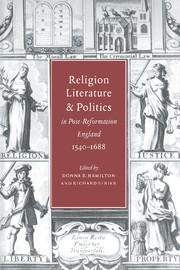Book contents
- Frontmatter
- Contents
- List of contributors
- Introduction
- 1 Sir John Oldcastle as symbol of Reformation historiography
- 2 The “sacred hunger of ambitious minds”: Spenser's savage religion
- 3 Subversive fathers and suffering subjects: Shakespeare and Christianity
- 4 Kneeling and the body politic
- 5 Donne and the politics of devotion
- 6 Catholic, Anglican or puritan? Edward Sackville, fourth Earl of Dorset, and the ambiguities of religion in early Stuart England
- 7 Crucifixion or apocalypse? Refiguring the Eikon Basilike
- 8 Marvell, sacrilege, and Protestant historiography: contextualizing “Upon Appleton House”
- 9 Entering The Temple: women, reading, and devotion in seventeenth-century England
- 10 Contextualizing Dryden's Absalom: William Lawrence, the laws of marriage, and the case for King Monmouth
- 11 Reformation in the Restoration Crisis, 1679–1682
- 12 Shadwell's dramatic trimming
- Index
Introduction
Published online by Cambridge University Press: 16 October 2009
- Frontmatter
- Contents
- List of contributors
- Introduction
- 1 Sir John Oldcastle as symbol of Reformation historiography
- 2 The “sacred hunger of ambitious minds”: Spenser's savage religion
- 3 Subversive fathers and suffering subjects: Shakespeare and Christianity
- 4 Kneeling and the body politic
- 5 Donne and the politics of devotion
- 6 Catholic, Anglican or puritan? Edward Sackville, fourth Earl of Dorset, and the ambiguities of religion in early Stuart England
- 7 Crucifixion or apocalypse? Refiguring the Eikon Basilike
- 8 Marvell, sacrilege, and Protestant historiography: contextualizing “Upon Appleton House”
- 9 Entering The Temple: women, reading, and devotion in seventeenth-century England
- 10 Contextualizing Dryden's Absalom: William Lawrence, the laws of marriage, and the case for King Monmouth
- 11 Reformation in the Restoration Crisis, 1679–1682
- 12 Shadwell's dramatic trimming
- Index
Summary
In Blake's Jerusalem, the “Great Voice of the Atlantic” terrifies Albion with a series of questions, including “What is a Church? and what / Is a Theater? are they Two & not One? can they Exist Separate? / Are not Religion and Politics the Same?” Albion is not up to dealing with these questions, but students of English history and literature must be. The relationship between the church and the theater in post-Reformation England is indeed a vexed one, and Blake is being deliberately provocative in equating them, but the equation between religion and politics is less paradoxical. Blake's provocative question seems merely accurate for the period from the dissolution of the monasteries to the Glorious Revolution. This volume explores ways in which policies, lives, sermons, histories, and literary works all reflect and enact the connections between religion and politics in this period. We purposely include essays on canonical authors (Spenser, Shakespeare, Donne, Marvell, Dryden), on neglected genres (histories, sermons), on individual lives (Edward Sackville, fourth Earl of Dorset; women readers of Herbert's Temple), and on specific politico-religious controversies (the execution of Charles I; the legitimation of the Duke of Monmouth). We mean to cut across boundaries between fields (history, church history, literary criticism) and between literary and non-literary texts. We also mean to cut across boundaries between traditional periods.
- Type
- Chapter
- Information
- Publisher: Cambridge University PressPrint publication year: 1996
- 1
- Cited by



